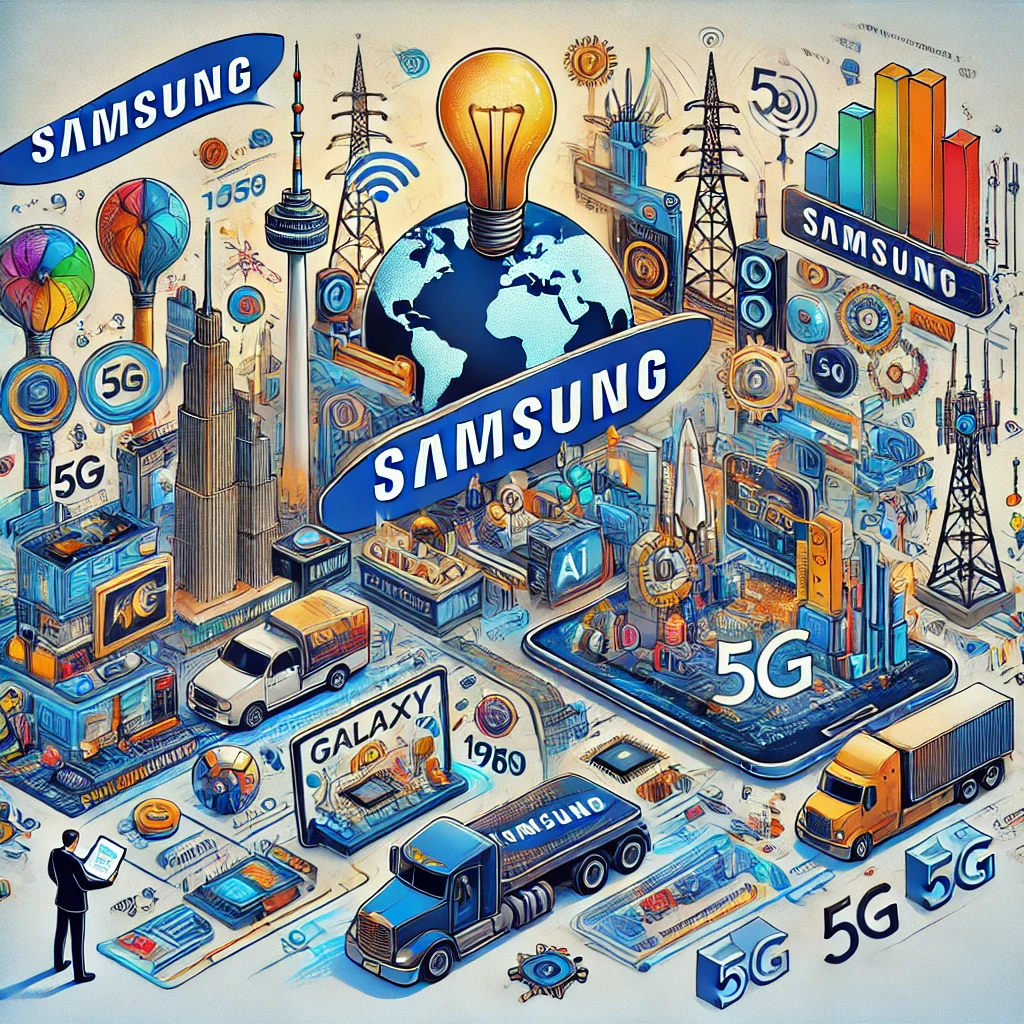Samsung, a South Korean multinational conglomerate, has risen from a small trading company founded in 1938 to a global leader in consumer electronics, information technology, and telecommunications. Its journey is a remarkable case of continuous innovation, strategic investments, and adaptability in a dynamic global market. Samsung’s business success can be attributed to its unique strategies that blend vertical integration, aggressive R&D, and market diversification, making it one of the world’s most influential tech companies.
Early Origins and Diversification (1938-1970)

Samsung began in 1938 as a small trading company, founded by Lee Byung-chul, dealing in dried fish, noodles, and other groceries. The company rapidly expanded into a variety of industries, including textiles, food processing, and insurance. However, it was not until the late 1960s that Samsung ventured into the electronics sector, which would eventually become the core of its global dominance.
First forays into Electronics

Samsung Electronics was established in 1969, marking the company’s entry into the electronic goods market. Initially producing low-cost consumer products like televisions, radios, and home appliances, Samsung recognized that electronics would be the engine driving the company’s future growth. The move toward semiconductors was a pivotal moment, with the production of integrated circuits (ICs) in the mid-1970s setting the foundation for its dominance in the global semiconductor industry.
Strategic Transformation: Vertical Integration and R&D Leadership (1980-2000)

Samsung’s growth strategy in the 1980s and 1990s was characterized by a heavy emphasis on vertical integration, allowing the company to control every stage of production—from manufacturing its own components (chips, display panels, batteries) to assembling the final products. This level of integration gave Samsung a competitive edge by allowing cost control, high product quality, and greater speed in bringing innovations to market.
Dominance in Semiconductor Industry

Samsung’s investment in semiconductor research paid off when it became the world’s largest producer of memory chips (DRAM and NAND flash) by the mid-1990s. This position allowed Samsung to become a supplier for many of its rivals, including Apple and Sony, thereby benefiting from industry growth even when its direct competitors succeeded.
Focus on Innovation and R&D
One of Samsung’s distinguishing strategies was its commitment to research and development (R&D). By the late 1990s, Samsung was spending billions annually on R&D, focusing on key technologies such as display panels, memory chips, and smartphones. By maintaining a strong focus on innovation, Samsung was able to leapfrog competitors and remain at the forefront of technological advancements.
First Major Global Success: LCD TVs
During this era, Samsung became the global leader in television production, particularly with its advances in liquid crystal display (LCD) technology. In 1993, Samsung launched its first 46-inch LCD TV, which was a significant milestone in the company’s television business. This marked the beginning of its transition from low-cost manufacturer to a premium electronics brand.
Rise in Mobile and Consumer Electronics: Samsung’s Galaxy Moment (2000-2020)
Samsung’s mobile phone business was an important turning point for the company. In the early 2000s, Samsung began shifting its mobile phone strategy from low-cost feature phones to high-end smartphones, culminating in the launch of the Galaxy series in 2010. This was a direct challenge to Apple’s iPhone, positioning Samsung as one of the world’s most innovative and competitive smartphone manufacturers.
The Galaxy Revolution
The Galaxy smartphone series proved to be a resounding success, helping Samsung dominate the global smartphone market. Leveraging Android’s open-source nature, Samsung customized and optimized the operating system for its devices, attracting millions of users globally. The flagship Galaxy S series, launched in 2010, not only rivaled Apple’s iPhone but also catered to a wide range of consumer needs, from affordable mid-range phones to premium flagship devices.
Component Manufacturing and Vertical Integration
Samsung’s unique competitive advantage in the mobile industry lies in its vertical integration strategy. While most competitors outsource components, Samsung manufactures key parts in-house, including screens, processors, memory chips, and batteries. This allows Samsung to control its supply chain, reduce production costs, and launch innovations quicker than competitors.
Business Strategies Driving Success
Samsung’s business strategy has always centered on a few core principles that enable it to navigate a highly competitive tech industry:
- Vertical Integration
- Samsung controls every aspect of its supply chain, from raw materials to finished goods. This vertical integration allows Samsung to be independent from external suppliers, ensuring better quality control, cost efficiency, and faster time-to-market.
- This strategy has been key in sectors such as memory chips, display technology (e.g., AMOLED and QLED), and batteries. For instance, Samsung’s ability to produce its own OLED panels gave it a competitive edge in the premium smartphone market.
- Global Reach and Localization
- Samsung’s approach to different regional markets has been another driver of success. In developed economies like the United States, Europe, and South Korea, Samsung positions itself as a premium brand, while in emerging markets such as India, Africa, and Southeast Asia, it focuses on delivering cost-effective, high-quality products tailored to local needs.
- Aggressive R&D Investments
- Samsung consistently invests heavily in R&D, pouring nearly 9% of its annual revenue into cutting-edge technology. This strategy has positioned Samsung at the forefront of innovations in areas like 5G technology, foldable phones, quantum-dot displays, and semiconductor fabrication.
- Partnerships and Ecosystem Expansion
- Samsung has partnered with major global brands such as Google, Netflix, and others to enhance the capabilities and user experience of its products. By doing so, Samsung integrates a seamless ecosystem of software and services across its hardware portfolio, improving brand loyalty.
Challenges and Controversies

Galaxy Note 7 Battery Crisis (2016)
Despite its success, Samsung has faced significant challenges, notably the Galaxy Note 7 battery crisis in 2016. Several incidents of Note 7 phones catching fire due to faulty batteries led to a global recall, costing Samsung over $5 billion and damaging its reputation. However, Samsung managed to recover from the crisis by implementing stricter quality control measures, ensuring that subsequent models like the Galaxy S8 and Note 8 regained consumer trust.
Legal and Ethical Controversies
Samsung has also been embroiled in multiple legal battles, including patent disputes with Apple and allegations of antitrust practices in the semiconductor industry. In addition, the company faced scandals related to labor conditions in its supply chain and accusations of exploiting workers in factories in developing countries.
Recent Developments: Samsung’s Future
5G, AI, and IoT Leadership
As the world transitions into the era of 5G technology, AI, and the Internet of Things (IoT), Samsung is positioning itself as a leader in these emerging fields. It has already introduced 5G-enabled smartphones and is working on smart home devices, IoT solutions, and autonomous vehicle components that are expected to dominate the future tech landscape.
Semiconductor Industry
Amid a global shortage of semiconductors, Samsung is expanding its investment in this space to solidify its position as the world’s largest chipmaker. The company announced plans to invest more than $116 billion by 2030 to build new semiconductor manufacturing plants and enhance its R&D efforts in this field.
Sustainability Initiatives
In recent years, Samsung has also been focused on sustainability and reducing its carbon footprint. The company has introduced initiatives to make its products more environmentally friendly, including the use of recycled materials and energy-efficient manufacturing processes.
Conclusion
Samsung’s journey is one of extraordinary transformation, from a small trading firm to a global tech giant. Its success can be attributed to its ability to innovate continuously, adapt to changing market conditions, and strategically diversify its business. From vertical integration to aggressive R&D investments, Samsung has positioned itself as a leader in multiple industries, including smartphones, semiconductors, televisions, and home appliances.
While the company has faced its share of controversies and challenges, its resilience and forward-thinking strategies have allowed it to maintain its position as one of the world’s most influential corporations. As Samsung ventures into the future, its investments in 5G, AI, and semiconductor technology ensure that it will remain at the forefront of global technological advancements for years to come.
45 FAQs about Samsung’s Business Journey, Strategies, and Impact:
- What year was Samsung founded?
Samsung was founded in 1938 by Lee Byung-chul in South Korea. - What was Samsung’s initial business focus?
Initially, Samsung was a trading company that dealt in groceries, dried fish, noodles, and other goods. - When did Samsung enter the electronics industry?
Samsung entered the electronics industry in 1969 with the creation of Samsung Electronics. - What are the key products in Samsung’s electronics division?
Key products include smartphones, televisions, semiconductors, home appliances, and display panels. - What is vertical integration, and how does Samsung use it?
Vertical integration means controlling every stage of production, from manufacturing components to assembling products. Samsung uses it to control its supply chain and reduce costs. - When did Samsung become a leader in the semiconductor industry?
Samsung became a global leader in semiconductors in the mid-1990s, particularly in memory chips (DRAM and NAND flash). - What was Samsung’s first major global success in consumer electronics?
Samsung’s first major success was in the television market with the launch of its advanced LCD TVs in the 1990s. - What is the Galaxy smartphone series, and why is it important?
The Galaxy series, launched in 2010, is Samsung’s flagship line of smartphones and a key competitor to Apple’s iPhone. - How did Samsung recover from the Galaxy Note 7 battery crisis?
Samsung introduced stricter quality control measures and regained consumer trust with subsequent models like the Galaxy S8. - How does Samsung’s vertical integration give it an advantage in the smartphone market?
By producing key components in-house, Samsung can reduce costs, ensure high-quality standards, and speed up product launches. - What role does R&D play in Samsung’s business strategy?
Samsung invests heavily in R&D to innovate in areas like semiconductors, displays, and mobile technology. - How does Samsung’s business strategy differ in developed vs. emerging markets?
In developed markets, Samsung focuses on premium products, while in emerging markets, it provides affordable, high-quality goods. - What are some of Samsung’s key markets?
Key markets include the United States, Europe, South Korea, India, and Southeast Asia. - What impact does Samsung have on the global semiconductor market?
Samsung is the largest producer of memory chips and a major player in the global semiconductor industry. - How did Samsung become a major player in the smartphone industry?
Samsung’s focus on innovation, vertical integration, and the success of the Galaxy series positioned it as a major smartphone player. - What are Samsung’s key innovations in mobile technology?
Innovations include foldable phones, 5G technology, AMOLED displays, and advancements in smartphone cameras. - How did Samsung become a leader in display technology?
Samsung invested heavily in research for OLED and LCD technologies, allowing it to dominate the display panel market. - What challenges has Samsung faced over the years?
Challenges include the Galaxy Note 7 battery crisis, legal battles with Apple, and labor issues in its supply chain. - How did Samsung respond to the global semiconductor shortage?
Samsung announced plans to invest over $116 billion by 2030 to expand its semiconductor manufacturing capabilities. - What is Samsung’s approach to sustainability?
Samsung is focused on reducing its carbon footprint by using recycled materials and improving energy efficiency in its products. - What makes Samsung’s supply chain unique?
Samsung’s vertically integrated supply chain allows the company to control every stage of production, which enhances efficiency and quality. - What role does Samsung play in the 5G revolution?
Samsung is one of the pioneers in 5G technology, having launched several 5G-enabled devices and investing in network infrastructure. - How does Samsung balance innovation with cost control?
By investing in vertical integration and R&D, Samsung can introduce innovative products while keeping production costs low. - What were Samsung’s early electronics products?
Samsung’s early products included black-and-white TVs, radios, and home appliances like washing machines and refrigerators. - What is Samsung’s approach to market diversification?
Samsung operates in multiple industries, including consumer electronics, semiconductors, telecommunications, and heavy industries. - Why is Samsung a key supplier for other tech companies?
Samsung produces components like memory chips, display panels, and batteries, which are used by companies such as Apple, Sony, and Huawei. - What is Samsung’s biggest product category today?
Smartphones, particularly the Galaxy series, remain Samsung’s largest and most profitable product category. - How does Samsung maintain its competitive edge in the tech industry?
Through continuous innovation, heavy R&D investment, vertical integration, and strategic market positioning. - What is Samsung’s corporate vision for the future?
Samsung aims to lead in areas like AI, IoT, 5G, and sustainable technology, continuing its focus on innovation and global leadership. - How has Samsung contributed to South Korea’s economy?
Samsung is South Korea’s largest company and a significant contributor to its GDP, employment, and global exports. - What is Samsung’s most popular smartphone model?
The Galaxy S series and the foldable Galaxy Z series are some of the most popular models in Samsung’s portfolio. - How does Samsung cater to emerging markets?
Samsung offers affordable smartphones, feature phones, and home appliances tailored to the needs and economic conditions of emerging markets. - What are Samsung’s key business units?
Samsung’s key business units include Samsung Electronics, Samsung Heavy Industries, Samsung Engineering, and Samsung Life Insurance. - What is Samsung’s approach to competition with Apple?
Samsung competes directly with Apple in the premium smartphone market, focusing on innovation, feature differentiation, and a broader product portfolio. - What is Samsung’s strategy for the IoT market?
Samsung is heavily investing in IoT technologies, creating smart home devices and interconnected ecosystems for its consumers. - How does Samsung ensure the quality of its products?
Samsung’s vertical integration, strict quality control measures, and focus on innovation ensure the high quality of its products. - What was the impact of the Galaxy Note 7 crisis on Samsung?
The crisis led to a global recall and a loss of billions of dollars, but Samsung regained market trust with improved safety measures and product launches. - How does Samsung’s investment in AI impact its business?
Samsung is investing in AI technologies for its smartphones, home appliances, and services, enhancing user experiences and automation. - What partnerships has Samsung formed to enhance its ecosystem?
Samsung has partnered with companies like Google, Netflix, and Spotify to integrate their services into its devices, enriching the user experience. - What is Samsung’s competitive advantage in the semiconductor industry?
Samsung’s massive scale, advanced manufacturing processes, and R&D capabilities give it a significant edge in the semiconductor market. - What are Samsung’s flagship home appliances?
Samsung’s flagship home appliances include smart refrigerators, washing machines, air conditioners, and robotic vacuums. - What role does Samsung play in the development of foldable smartphones?
Samsung is a pioneer in foldable technology, launching foldable smartphones like the Galaxy Z Fold and Galaxy Z Flip, reshaping the mobile market. - What is Samsung’s approach to corporate social responsibility (CSR)?
Samsung focuses on sustainability, education, and social initiatives that improve communities and reduce environmental impacts. - How does Samsung’s global reach benefit its business?
Samsung’s global reach allows it to scale operations, cater to diverse markets, and sustain leadership in various industries. - What future technologies is Samsung focusing on?
Samsung is focusing on 5G, AI, IoT, autonomous vehicles, and advanced semiconductor manufacturing to remain at the forefront of technological advancements.



